This is an old revision of this page, as edited by Filll (talk | contribs) at 23:10, 25 August 2007. The present address (URL) is a permanent link to this revision, which may differ significantly from the current revision.
Revision as of 23:10, 25 August 2007 by Filll (talk | contribs)(diff) ← Previous revision | Latest revision (diff) | Newer revision → (diff) This article is a non-technical introduction to the subject. For the main encyclopedia article, see Evolution.| Overview |
| Life forms reproduce to make offspring. |
| The offspring differs from the parent in minor random ways. |
| If the differences are helpful, the offspring is more likely to survive and reproduce. |
| This means that more offspring in the next generation will have the helpful difference. |
| These differences accumulate resulting in changes within the population. |
| Over time, this process gradually leads to entirely new types of life. |
| This process is responsible for the many diverse life forms in the world today. |
Evolution is change in populations of organisms over generations. Offspring differ from their parents in various ways. When these differences are helpful, the offspring have a greater chance of surviving and reproducing, making the differences more common in the next generation. In this way, differences can accumulate over time, leading to major changes in a population.
Evolution occurs through changes in genes, the "recipes" for constructing the organism. When an organism reproduces, small random changes in the genes make the offspring different from the parent. Sometimes these changes help the offspring survive to reproduce. When this happens, the genes for the beneficial traits are passed on to the organism's own offspring, becoming more common in the next generation. Genes that do not help organisms reproduce may become rarer or be completely eliminated from the population. This is called natural selection, a major part of evolution. Through natural selection, populations of organisms slowly change over time as they adapt to changes in their environments.
The scientific theory of evolution—the explanation for how evolution occurs—states that all living things are descended from a single common ancestor at some point in the distant past. This idea is called common descent. Since the beginning of life, evolution has transformed the first species into more and more different species as life has found a variety of ways to survive and flourish. This has resulted in the many diverse forms of life that exist today.
 |
Darwin's idea
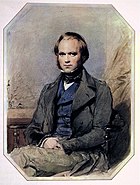 Charles Darwin proposed the theory of evolution by natural selection.
Charles Darwin proposed the theory of evolution by natural selection.
|
| File:Mendel.png Gregor Mendel's work on the inheritance of traits laid the foundation for genetics. |
The idea of common descent developed in the 18th century as increasing numbers of species were found and classified, with Buffon introducing the concept of classification relating to historical shared ancestry. In 1809 Lamarck proposed a mechanism of transmutation of species to explain this descent. While on the voyage of the Beagle from 1831 to 1836, Charles Darwin found that fossil species were unexpectedly closely related to modern species of organisms in the same area, and the territory of species suggested that they had spread with changes from nearby species rather than just arising in place. To explain these relationships, he proposed that all living things are related and have descended from a common ancestor in a process which he described as "descent with modification".
Darwin's explanation of the mechanisms of evolution relies on his theory of natural selection. The modern theory of natural selection incorporates five basic ideas:
- Organisms will produce more offspring than their habitat can sustain. There will be a "struggle to survive".
- Not all the offspring will be identical.
- Some of the differences between the offspring will be due to variations in their genetic makeup, the "code" that determines each organism's inherited traits.
- Genetic variations that help an organism to survive and reproduce are more likely to be passed on to the next generation than genetic variations that are unhelpful.
- Over time, helpful genetic variations will accumulate until a new species results.
Mendel’s contribution
Darwin’s theory of natural selection laid the groundwork for evolutionary theory, although he lacked an accurate explanation for the source of the variations within the population. Darwin, like many of his predecessors including Jean-Baptiste Lamarck, deduced that heritable traits were a product of the environment, but early views of evolution tended also to assume that characteristics acquired during an organism's lifetime could be passed on to its offspring (e.g. giraffes stretching for leaves on higher branches would give birth to offspring with longer necks). This misconception, known as the inheritance of acquired characteristics, has been shown to be incorrect. It was the emergence of the field of genetics, pioneered by Gregor Mendel (1822-1884), that provided the missing information necessary to help explain the emergence of new traits in the offspring. Mendel’s experiments with breeding pea plants led him to realize that heredity in sexual reproduction works by reshuffling and recombining factors (genes) during sexual reproduction. It is this reshuffling of the genetic code that ensures that no two individuals will be exact copies. The merging of Darwin's theory with an understanding of heredity led to the birth of the field of science called "population genetics".
Population genetics
Some definitions
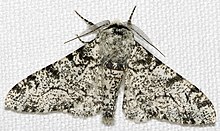
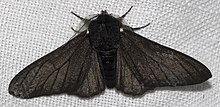
A more sophisticated definition of evolution is "a generation-to-generation change in the frequencies of alleles within a population that shares a common gene pool." To understand this definition, it helps to know the technical words used
- Genes are the basic units of heredity in living organisms. A gene is a segment of a DNA molecule on a chromosome, and between them the genes direct the physical development and behavior of the organism.
- Alleles are the different forms of a given gene that an organism may possess. For example, in moths, one allele of the body-color gene produces a black moth and another allele of the body-color gene produces a white moth.
- A population is a localized group of individuals belonging to the same species. For example, all the trout of the same species sharing a single stream is a population.
- A gene pool is the sum of all the alleles shared by members of a single population.
- Each allele occurs a certain number of times in a population. The fraction of genes that belong to a given allele is called the "allele frequency". So if half of the body-color genes are genes for black moths, then the black-body allele frequency is 0.50.
Hardy-Weinberg equilibrium
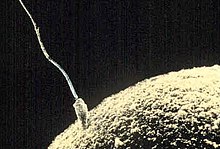
To understand the mechanisms that allow a population to evolve, it might be useful to consider the gene pool of a non-evolving population. A theory known as the "Hardy-Weinberg principle" states that the frequencies of alleles in a sufficiently large population’s gene pool will not change over time unless acted upon by forces other than:
- random reshuffling of alleles during the formation of the gametes, such as the sperm and egg.
- random combination of the genes in these sex cells during fertilization, the process in which the egg and sperm combine to form a new cell.
An example

In a population of mice that inhabit a barn, suppose there are only two variations in the gene controlling fur color. One allele codes for black fur and accounts for 75% of the gene pool. The other allele codes for white fur, which accounts for the remaining 25% of the gene pool. If an allele’s potential to be passed on to the next generation is due entirely to random processes (the shuffling and combining that takes place in the formation of sex cells and fertilization), the frequencies will remain 75% black and 25% white. In this case there are no changes in the frequencies of alleles in the mouse population. Since there is no change in the allelic frequencies, there is no evolutionary change (at least in regards to fur color). Such a population is said to be in "Hardy-Weinberg equilibrium".
For this equilibrium to persist (no evolution), the following conditions must be met:
- The population must be large. Small populations are subjected to chance fluctuations in the gene pool, a condition known as genetic drift.
- There can be no exchange of members between populations. Such migration between populations is called gene flow.
- The mutation rate must be insignificant. Mutations introduce new variations in a trait and thus change the frequency of the pre-existing alleles.
- Mating must be random. There can be no preference for any particular allele during mate selection.
- Natural selection cannot be a factor. The chance that each allele has for survival and reproduction must be the same.
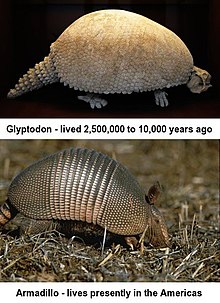
Such situations rarely, if ever, exist in a natural population. Therefore, frequencies of alleles in a gene pool are always changing, resulting in evolution of populations over successive generations.
Evidence of evolution
Many fields of science have provided a wide range of evidence for evolution. The most prominent of these are fossil records, which can show the many life forms that have existed. The fossil itself reveals the organism's structure, and the age of the fossil reveals when its species existed. In addition, studies involving anatomical and genetic comparisons between present day species serve as evidence for evolution.
 French naturalist and zoologist Georges Cuvier studied fossils.
French naturalist and zoologist Georges Cuvier studied fossils.
|
 Archaeopteryx fossil.
Archaeopteryx fossil.
|
The fossil record
Paleontology, the study of fossils, supports Darwin's original idea that all living creatures are related. Fossils also provide evidence that accumulated changes over long periods have led to the diverse forms of life we see today.
Modern paleontology was developed primarily by Georges Cuvier (1769-1832). Cuvier noted that in sedimentary rock each layer was defined by a specific group of fossils. The deeper (older) the layer, the simpler the life forms. He also noted that many forms of life that existed in the past are no longer represented in the present. Cuvier proposed the idea of catastrophism, which he used to explain the fossil record in the light of the theological views of his time. He proposed that catastrophes had occurred in localized areas throughout the earth’s history. Such areas were then repopulated by species that migrated in from nearby locations.
Today, the fossil record is more complete, and serves as a chronological record documenting the emergence of new, more complex species from simpler ancestral forms. The fossil record also provides some examples of transitional species that provide evidence of ancestral links between species that exist today.
Perhaps the best known of these transitional fossils is Archaeopteryx. Archaeopteryx is the fossil of an ancient creature that has the distinct characteristics of a reptile, yet clearly possesses the feathers of a bird. The implication from such a find is that modern reptiles and birds arose from a common ancestor.
Comparative anatomy
Taxonomy is the branch of biology that names and classifies all living things. The founder of the science of taxonomy was Carolus Linnaeus (1707-1778). Linnaeus placed organisms into categories based on the similarities of their physical features (sometimes called their "morphology"). Curiously, he never suggested that organisms which fell into similar groups were related. Today, scientists still use morphological similarities to assist them in categorizing life forms. However, the bases of such groupings are the ancestral relationships that link them. For example, orangutans, gorillas, chimpanzees, and humans all belong to the same taxonomic grouping referred to as a family – in this case the family called "Hominidae". These animals are grouped together because of similarities in morphology which they share as a result of common ancestry. A similarity in anatomical features as a result of shared ancestry is called homology.
 
|
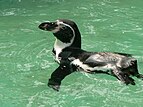  
|
Strong evidence for evolution comes from analysis of "homologous" structures that no longer perform the same task. One example involves the comparison of the forelimbs of mammals. The forelimbs of a human, cat, whale, and bat all have strikingly similar bone structure. However each of these four animals' forelimbs performs a different task. Such a "design" makes little sense if they are unrelated and uniquely constructed for their particular tasks. The scientific explanation for such homologous structures is that all four animals shared a common ancestor, and that each has undergone mutations over the course of a large number of generations. These changes have resulted in slight modifications in the structure, so that each species has a forelimb adapted for a different task. This is what Darwin described as "descent with modification".
Anatomical comparisons of embryonic structures provide evidence for a shared ancestor that might not be obvious in the adult forms. Such homologies might be lost or take on different functions as the embryo develops. For example, part of the basis of classifying the vertebrate group (which include humans), is the presence of a tail and pharyngeal gill slits. These structures are not always apparent in the adult forms. A common misconception is that organisms re-enact their evolutionary history during fetal development. In the case of humans, some claim that human embryos pass through amphibian then reptilian stages. This misconception is known as “ontogeny recapitulates phylogeny”. Such a re-enactment of evolution during embryonic development is not supported by the scientific evidence.
Vestigial structures

Homology also includes a unique group of shared structures referred to as "vestigial structures". The term "vestigial" refers to anatomical parts that are of minimal, if any, value to the organism that possesses them. The most widely held explanation for such apparently illogical structures is that they are remnants of organs that likely played an important role in ancestral forms. For example, whales still possess small vestigial leg bones which appear to be remnants of the legs that their ancestors used to walk on land.
Humans also have many vestigial structures. Human vestigial structures include the ear muscles, the wisdom teeth, the appendix, the tail bone, body hair (including goose bumps), and the semilunar fold in the corner of the eye.
Convergent evolution
 
|
Anatomical comparisons can also be misleading. Organisms which share similar environments will often develop similar physical features. This is known as "convergent evolution". For example, both sharks and dolphins have similar body forms, yet are only distantly related, the first being a fish and the second a mammal. Such similarities are a result of both populations being exposed to the same selective pressures. Within both groups, random mutations that produce bodies that are more efficient for swimming would be favored. Thus, over time, they develop similar morphology.
Artificial selection

Artificial selection is the controlled breeding of domestic plants and animals. In controlled breeding, humans determine which animals will reproduce, and to some degree, which genetically determined traits will be passed to future generations. The process of artificial selection has had a significant impact on the evolution of many domestic animals. For example, people have produced many different types of dogs by controlled breeding. The differences between the Chihuahua and the Great Dane are the result of artificial selection.
Darwin drew much of his support for natural selection from observing the outcomes of artificial selection. Much of his book On the Origin of Species was based on his observation of the diversity in domestic pigeons as a result of artificial selection. Darwin proposed that if dramatic changes in domestic plants and animals could be achieved by humans in short periods of time, then natural selection, given millions of years, could account for the differences seen in living things today. In fact, there is no real difference in the genetic processes underlying artificial and natural selection. Like natural selection, the variations are a result of random chance mutations; the only difference being that in artificial selection, humans select which traits will be represented in future members of the breeding population.
Molecular biology
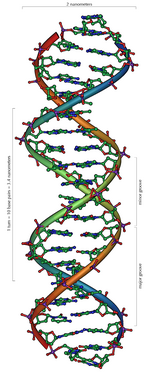
Every living organism contains DNA, RNA, and proteins. The more closely related the organisms the higher the degree of similarities in the molecular structure of these three substances. For example, in humans, siblings share the closest relationship possible, a fact validated by their very similar DNA sequences. The field of molecular systematics focuses on working out evolutionary relationships based on the similarities of these molecules. Such molecular comparisons have allowed biologists to build a "relationship tree" that shows the probable evolution of various organisms. Scientists have made great strides in analyzing the chemical compounds (sequencing the nucleotides) that make up the genetic code. Since morphology (the phenotype) is an outward expression of that genetic code (the genotype), then an analysis of the genes themselves should provide an even clearer understanding of the relationships between species.
Comparing both DNA and amino acid sequences has been extremely useful when studying species that are so closely related that there are no obvious anatomical differences. The extent of their relationship can be determined based on the premise that the closer the relationship between species, the greater the similarities between their genetic codes.
Genetic comparisons also allow scientists to draw conclusions about organisms whose common ancestors lived such a long time ago that morphological similarities are not apparent. For example, comparison of the DNA sequences in chimpanzees with those of gorillas and humans has demonstrated that chimpanzees share more genetic similarities with humans than with gorillas. Therefore, this implies that these two species, humans and chimpanzees, share a closer evolutionary relationship as well.
Co-evolution
Co-evolution is a process in which two or more species influence the evolution of each other. At first analysis it may seem that all living things, at least to some degree, are influenced by life around them. However, to meet the strictest scientific definition of "co-evolution", there must be evidence that at least some traits in each species are the result of the interaction between the two organisms.
The most extensively documented example of co-evolution involves the relationship between an ant called Pseudomyrmex and the acacia, a plant that the ant uses for both food and shelter. The relationship between the two is so intimate that it has led to the evolution of special structures and behaviors in both organisms. The ant defends the acacia against herbivores and removes parasitic fungi from the acacia. In return, the plant has evolved swollen thorns which the ants use as shelter, and special flower parts which the ants eat.
Such co-evolution does not imply that the ants and the tree somehow choose to behave in such an altruistic manner for each others' benefit. Rather, across a population small genetic changes in both ant and tree benefited each on its own accord. The benefit gave a slightly higher chance of the characteristic being passed on to the next generation, where it gave the new tree (and the new ant colony) a greater chance of survival. Over time, successive mutations created the relationship we observe today.
Species
Given the right circumstances, and enough time, evolution leads to the emergence of new species. Scientists have struggled to find a precise and all-inclusive definition of a species, but the classic definition, used here, was developed by Ernst Mayr (1904-2005). Mayr defined a species as a population or group of populations whose members have the potential to interbreed naturally with one another to produce viable, fertile offspring. Also, the members of a species cannot produce viable fertile offspring with members of other species. ".
Speciation is the lineage-splitting event that results in two separate species forming from a single common ancestral population. The most widely accepted method of speciation is called "allopatric speciation". This method of speciation requires the geographic separation of a population. Separation may be due to a variety of geological forces such as the emergence of mountain ranges or the formation of canyons. For speciation to occur, separation must be complete to the point that genetic exchange between the two populations is completely disrupted. In their separate environments, the genetically isolated groups follow their own unique evolutionary pathways. Each group will accumulate different mutations as well as be subjected to different selective pressures. The accumulated genetic changes may result in separated populations no longer being capable of interbreeding should they be reunited. If interbreeding is no longer possible, then they would be considered different species.
Reproductive barriers that prevent interbreeding can be classified as either prezygotic barriers or postzygotic barriers.
 Firefly
Firefly
|
| File:100 0637.jpg A mule |
Prezygotic barriers
Prezygotic barriers prevent mating between species or prevent the fertilization of the egg if the species attempt to mate. Some examples are:
- Temporal isolation - Occurs because species mate at different times.
- Behavioral isolation - Signals that elicit a mating response may be sufficiently different to prevent a desire to interbreed. The rhythmic flashing in male fireflies is species-specific and thus serves as a prezygotic barrier.
- Mechanical isolation - Anatomical differences in reproductive structures may prevent interbreeding. This is especially true in flowering plants that have evolved specific structures adapted to certain pollinators.
- Gametic isolation - The gametes of the two species are chemically incompatible, thus preventing fertilization.
- Geographic/habitat isolation - Geographic: The two species are separated by large-scale physical barriers, such as a mountain or large body of water, and therefore cannot mate with each other. Habitat: The two species prefer different habitats, even if they live in the same general area, and therefore do not come into contact with each other.
Postzygotic barriers
Postzygotic barriers occur after fertilization, usually resulting in the formation of a hybrid zygote that is neither viable nor fertile. This is typically a result of incompatible chromosomes in the zygote. Some examples include:
- Reduced hybrid viability - A barrier between species occurs after the formation of the zygote, resulting in incomplete development and death of the offspring.
- Reduced hybrid fertility - Even if two different species successfully mate, the offspring produced may be infertile. The mating of horses and donkeys results in reduced hybrid fertility The offspring of a horse and a donkey is either a mule, or a hinny, which are both usually infertile.
- Hybrid breakdown - Some hybrids are fertile for a single generation but then become weak or inviable.
Different perspectives on the mechanism of evolution
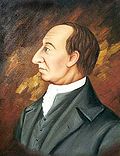
|
| James Hutton |
| File:NaturalhistoryMag.jpg |
| Stephen Jay Gould |

|
| Richard Dawkins |
The theory of evolution is widely accepted among the scientific community. It serves to link the diverse specialty areas of biology. Evolution provides all of biology with a solid scientific base. The significance of evolutionary theory is best described by the title of a paper by Theodosius Dobzhansky (1900-1975), published in American Biology Teacher; "Nothing in Biology Makes Sense Except in the Light of Evolution."
Nevertheless, the theory of evolution is not dogmatic. In fact, there is much discussion within the scientific community concerning the mechanisms behind the evolutionary process. Two such areas of debate are:
- The rate at which evolution occurs
- The unit of evolutionary change, the organism or the genes
Rate of change
Two general views exist concerning the rate of evolutionary change. Darwin and his contemporaries viewed evolution as a slow and gradual process. Evolutionary trees are based on this idea, that profound differences in species are the result of many small changes that have accumulated over great periods of time.
This view had its basis in the works of the geologist James Hutton (1726-1797) and his theory called "Gradualism". Hutton's theory suggests that profound geological change is the cumulative product of slow but continuous processes. A similar perspective was adopted for biological changes.
Such a view falls short in explaining the fossil record, which shows evidence of new species appearing suddenly, then persisting in that form for long periods. Stephen Jay Gould (1940-2002) developed a model that suggests that evolution continues through periods of rapid change alternating with periods of relative stability, a model called "Punctuated Equilibrium".
Unit of change
It is generally accepted amongst biologists that the unit of selection in evolution is the organism, and that natural selection functions as variant individual organisms are eliminated within a population due to their relative fitness. Reproductive success, therefore, can be measured by the volume of an organism's surviving offspring. This view has come under challenge from a variety of biologists, as well as philosophers. Richard Dawkins, for example, proposes that much insight can be gained if we look at evolution from the gene's point of view, and view natural selection as selecting amongst genes, in addition to organisms. This perspective is captured in the following quotation from his book, The Selfish Gene:
Individuals are not stable things, they are fleeting. Chromosomes too are shuffled to oblivion, like hands of cards soon after they are dealt. But the cards themselves survive the shuffling. The cards are the genes. The genes are not destroyed by crossing-over, they merely change partners and march on. Of course they march on. That is their business. They are the replicators and we are their survival machines. When we have served our purpose we are cast aside. But genes are denizens of geological time: genes are forever.
Others view selection working on many levels, not just at a single level of organism or gene; for example, the paleontologist Stephen Jay Gould called for a hierarchical perspective on selection.
Summary
| Evolution in popular culture |
| As Darwin's work spread and became better known, references to it began appearing in the popular culture of the day. Some of the better-known Victorian references to it include: |
| "Survival of the fittest" - used by Herbert Spencer in Principles of Biology (1864) |
| "Nature, red in tooth and claw" - from Alfred Lord Tennyson's In Memoriam A.H.H. (1849) |
| It even merited a song in Gilbert and Sullivan's 1884 opera, Princess Ida, which concludes: "Darwinian man, though well behaved, |
Evolution is a scientific theory that provides a mechanism to account for the variety of biological species we observe. Evolution is the result of two basic mechanisms:
- Evolution requires genetic variation within the population. Offspring are not perfect copies of their parents, or each other. If they were, the only factor determining survival and reproductive success would be random chance.
- Some offspring might have features that allow them to survive and thrive better than others. The offspring that survive will be more likely to have offspring of their own. Some of these useful features are passed along to new generations.
Therefore, evolution is an inevitable result of imperfectly copying, self-replicating machines reproducing over billions of years under the selection pressure of the environment.
There is a tremendous amount of evidence that is explained by evolution. Evolution has been observed in the laboratory. Domesticated animals evolve as we selectively breed them for certain traits. The records of past evolution are found in fossils as well as in our fundamentally similar genetic codes, demonstrating common ancestry of all organisms, both surviving and extinct.
Evolution is one of the most successful scientific theories ever produced and is widely accepted by biological scientists. An understanding of evolution underlies all biological sciences and much of medicine.
Key points
- Evolution does not necessarily make lifeforms more "advanced", more intelligent, or more sophisticated. For example, fleas are descended from a winged, ancestral scorpionfly to become wingless parasites, and snakes are lizards that have lost the use for limbs.
- Evolution does not mean "progress" towards an ultimate goal; in fact, evolution is not goal-driven. Organisms are merely the outcome of mutations that succeed or fail, dependent upon the environmental conditions at that time.
- Humans don't have a special place at the top of the evolutionary tree. We are merely one of many branches.
- Evolution is not just something that has happened, resulting in the species we see today. It is a basic process of biology and is continuing.
- Evolution is not a random process for creating new life forms. Mutations are (partly) random, but natural selection is far from random.
- The scientific theory of biological evolution does not directly include the processes of stellar evolution or geological change. The Big Bang theory and the formation of the solar system are not parts of the theory of evolution.
- Evolution does not attempt to describe the process which brought forth life on earth (such as abiogenesis or some other method).
- Populations, not individuals, evolve; evolution does not describe how a child matures into an adult, or how a tree grows from a seed.
- The use of the word "theory" in the "theory" of evolution does not imply that evolution is any less well accepted or less supported by evidence than any other scientific theory, including the theory of gravity or the theory of quantum mechanics. A theory is a well-supported explanation for a given set of data, not a mere hypothesis.
- Evolution does not state that humans are descended from monkeys, or that human ancestors were monkeys. However, evolution implies that humans and present-day monkeys share a common ancestor.
- It is often claimed that evolution has never been observed. This is incorrect. Evolution has been observed in the laboratory and in the wild. Past evolution is recorded in fossils.
- It is sometimes claimed that evolution violates the second law of thermodynamics, as it increases the level of order. However, as the earth is not a closed system (notably it continually absorbs energy from the sun), there is no violation of the law.
- It is sometimes claimed that there is no evidence for evolution. This is incorrect. Evolution is supported by an immense body of scientific evidence. There is as much or more evidence for evolution as for many other scientific theories.
- There is no serious disagreement among biological scientists about the validity of evolution. Though some aspects of evolution, such as the mechanisms and processes that drive it, are subject to some professional debate, more than 99.9% of all professional biological scientists support evolution. It is the foundation of the research conducted in all fields of biology.
See also
- Evolution - the main Misplaced Pages article, with more detail than appears here, some of it highly technical
- Article on evolution from the Simple English edition of Misplaced Pages - a brief account in simple English
- For a more comprehensive list of topics, see Category:Evolution and Category:Evolutionary biology
The following Misplaced Pages Main Articles provide additional information on topics related to biological evolution:
- Common descent
- Convergent evolution
- Creation-evolution controversy
- Divergent evolution
- Evolution as theory and fact
- Evolution of sex
- Evolutionary biology
- Evolutionary tree
- Fossil
- Genetics
- Gradualism
- Level of support for evolution
- Natural selection
- Origin of life
- Paleontology
- Punctuated equilibrium
- Timeline of evolution
Further reading
- Berra TM (1990). Evolution and the myth of creationism: a basic guide to the facts in the evolution debate. Stanford, Calif: Stanford University Press. ISBN 0-8047-1548-3.
- Darwin C (1979). The illustrated Origin of species (abridged & introduced by Richard E. Leakey ; consultants: Bynum WF, Barrett JA). London: Faber and Faber. ISBN 0-571-11477-6.
- Dawkins R (1995). River Out of Eden: a Darwinian view of life. New York: Basic Books. ISBN 0-465-01606-5.
- Dawkins R (1996). Climbing Mount Improbable. New York: W.W. Norton. ISBN 0-393-03930-7.
- Dawkins R. The Selfish Gene. Oxford University Press, USA. ISBN 0-19-929114-4.
- Gould SJ (1980). The Panda's Thumb: more reflections in natural history. New York: Norton. ISBN 0-393-01380-4.
- Gould SJ (1995). Dinosaur in a haystack: reflections in natural history. New York: Harmony Books. ISBN 0-517-70393-9.
- Gould SJ (1989). Wonderful life: the Burgess Shale and the nature of history. New York: W.W. Norton. ISBN 0-393-02705-8.
- Mayr E (2001). What evolution is. New York: Basic Books. ISBN 0-465-04425-5.
- Ridley M (2003). The Red Queen : Sex and the Evolution of Human Nature. New York, NY: Perennial. ISBN 0-06-055657-9.
- Sagan C, Druyan A (1992). Shadows of forgotten ancestors: a search for who we are. New York: Random House. ISBN 0-394-53481-6.
- Sis P (2003). The tree of life: a book depicting the life of Charles Darwin, naturalist, geologist & thinker. New York: Farrar Straus Giroux. ISBN 0-374-45628-3.
External links
Evolution websites
- Understanding Evolution from University of California, Berkeley
- Howstuffworks.com — How Evolution Works
- The Talk Origins Archive: Exploring the Creation/Evolution Controversy
- Evolution by Natural Selection - An outline of the chain of reasoning behind the theory of natural selection
- evowiki - A reader-built encyclopedia of evolution, biology, and origins
Videos about evolution
- Evolution (provided by PBS)
- Evolution of Life Explained by Carl Sagan
- Natural Selection Explained by Carl Sagan
Printable Introduction to evolution
- The Big Picture on Evolution (pdf), with description, from the Wellcome Trust
Genetics
Notes
- ^ See Biology 7th Edition by Neil Campbell & Jane Reece. Several chapters are dedicated to the general principles of evolution.
- Genetics by Charlotte Avers. A chapter is dedicated to the general nature of mutations.
- ^ What Evolution Is by Ernst Mayr. A highly readable explanation of evolution. The chapter “What is the evidence for evolution” provides a non-technical explanation addressing the challenges of defending the theory of evolution against many of its adversaries.
- Johnston, Ian (1999). "Section Three: The Origins of Evolutionary Theory". . . . And Still We Evolve, A Handbook on the History of Modern Science. Liberal Studies Department, Malaspina University College. Retrieved 2007-08-12.
- John van Wyhe (2006). "Charles Darwin: gentleman naturalist". Retrieved 2007-08-17.
- The concept of a struggle to survive is echoed in the phrase "survival of the fittest". This metaphor for evolution, which in fact refers to a particular technical meaning of the word fitness, was originally coined by Herbert Spencer in his book Principles of Biology in 1864. Modern biologists prefer to describe evolution as "survival of the fit", however.
- See The Blind Watchmaker by Richard Dawkins for a good, simple work dealing with natural selection.
- See the introduction to Sean B. Carroll's Endless Forms Most Beautiful for more information about the development of evolutionary ideas.
- DNA is a long molecule that has the form of a "double helix". It resembles a ladder that has been twisted. The rungs of the ladder are formed by chemicals called nucleotides. There are four types of nucleotides, and the sequence of nucleotides carries the information in the DNA. There are short segments of the DNA called genes. The genes are like sentences built up of the "letters" of the nucleotide alphabet. Chromosomes are packages for carrying the DNA in the cells.
- Allele frequencies are often given as percentages. In this case, the allele frequency of black-body alleles is 50%.
- ^ For a fuller and deeper description of the Hardy-Weinberg principle, any modern biology textbook should suffice. One that covers it well (if briefly) is Starr and Taggert's Biology: The Unity and Diversity of Life (Tenth Edition).
- Template:Harvard reference Retrieved on 2006-12-15
- The Fossil Trail by Ian Tattersall. The chapter “Before Darwin” provides a synopsis of the history of paleontology.
- See Stephen Jay Gould's Hooking Leviathan by Its Past from Dinosaur in a Haystack and, for a short introduction to Cuvier, Wide Hats and Narrow Minds from the same author's The Panda's Thumb.
- See The Third Chimpanzee by Jared Diamond. Discusses homology as it relates to the diversity of primates; including humans.
- Most aquatic chordates respire by means of gills made of filaments lining the borders of gill slits which connect to the pharynx and open to the outside. Terrestrial chordates, which never breathe by means of gills, nevertheless have traces of gill slits present as transient structures during embryonic development (Weichert & Presch, Elements of Chordate Anatomy, New York: McGraw-Hill, 1975).
- "Vestigial Organs and Structures." in Encyclopedia of Evolution by Mark Pagel, editor in chief.
- The nucelotides are the chemicals that form the "rungs" of the twisted ladder of DNA. There are four types of nucleotides, and they are the "letters" of an alphabet that is used to carry information.
- Carroll SB, Grenier J, Weatherbee SD (2005). From DNA to Diversity: Molecular Genetics and the Evolution of Animal Design. Second Edition. Oxford: Blackwell Publishing. ISBN 1-4051-1950-0.
- Swollen-Thorn Acacias Central America by Daniel H Janzen.
- The Evolution of Charles Darwin by Frank J. Sulloway. A publication from the Smithsonian Institute.
- A zygote is a fertilized egg before it divides, or the organism that results from this fertilized egg.
- See Stephen Jay Gould's Opus 200 Downloaded 12 June 2007 for a further description of punctuated equilibrium and gradualism.
- While somewhat technical, Gould SJ, Lloyd EA (1999). "Individuality and adaptation across levels of selection: how shall we name and generalize the unit of Darwinism?". Proc. Natl. Acad. Sci. U.S.A. 96 (21): 11904–09. PMID 10518549. is a reasonably concise and detailed explanation of selection levels.
- Finding the Evolution in Medicine – Article in NIH Record (National Institutes of Health).